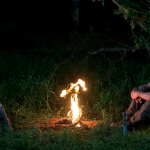There’s an episode of Nickelodeon’s animated TV show Avatar: The Last Airbender that serves as a recap of the show up to that point, as well as a brief respite before the final battles toward which the entire show has been heading. The recap episode is a staple of anime series, but Avatar does it in a unique way by having the main characters attend a stage play based on their own adventures. The inaccuracies and aesthetic offenses of the Ember Island Players’ portrayals of Team Avatar are legion; Aang, the boy who is both the Avatar and the Last Airbender of the title, is played on stage by a woman, à la Mary Martin in Peter Pan, with all the disgusting cutesiness she can muster. The Ember Island play flattens Aang’s character to a trickster fond of practical jokes, leaving out any gravitas we’ve come to see in the young chosen one.
After watching the live-action film The Last Airbender, I’ve decided to induct writer-director M. Night Shyamalan into the Ember Island Players Hall of Fame. Aang was not played by a woman, but that’s about the best I can say. In addition to being a travesty of the show, The Last Airbender is genuinely bad on its own merit.
I first encountered the TV show Avatar three years ago—and, as many before and since have, I fell in love. The show combines an Asian-inspired setting and characters with a Western storytelling style (which tends to make it more immediately accessible to Americans than most anime). I have to admit that the cute hybrid animals—turtle seals, badger moles, and penguin otters—are a big part of the draw for me, too, and their almost complete absence from the film (Aang’s flying bison Appa and his winged lemur Momo make token appearances from time to time, though Momo’s name is never mentioned) is just one way in which the fleshed-out world of the TV show is flattened for the big 3-D screen.
As in the Ember Island production within the TV show, The Last Airbender movie makes Aang’s character one-dimensional, though in the opposite direction. The film’s Aang is completely humorless, lacking the playfulness that makes Aang’s gradual acceptance of his role as Avatar—the one person who can keep any one of the four nations of Earth, Air, Fire, and Water from becoming too powerful and dominating the others—all the more poignant. (Also, oddly, the film pronounces Aang’s name to rhyme with “gong” rather than “gang,” and Sokka—“Sock -a”—is pronounced “Soak-a” or, occasionally, “Souk-a.”)
Shyamalan does at least deserve credit for giving Aang a distinct character arc in the movie, though his choice of arcs makes Aang less believable as a little boy. In a bizarre twist, in the film, Aang’s reason for running away when he’s first told that he’s the Avatar is that it means that he “can’t ever have a family.” What twelve-year-old boy would mourn over that? It’s much more plausible that the TV show’s Aang runs away both because he rebels against the discipline that being Avatar would impose on his fun-loving spirit and also because he truly fears bearing the weight of so much responsibility.
Besides accepting his role as Avatar, the other character arc the movie assigns to Aang is learning to grieve over, without the desire for revenge, the genocide of his people by the Fire Nation (who, in a rather Herodian move, slaughtered all the monk-like Air Nomads because they knew the Avatar would be born among them). This arc could work—with a better script and better acting/directing—but we would also need to see the potential consequences of Aang’s uncontrolled anger in order to understand why he would want to avoid it. The TV show addresses this issue through what’s known as the “Avatar state,” when Aang’s arrow tattoos begin glowing and he gains tremendous power. The Avatar state, which, in Book 1 of the show, is triggered by anger or fear on Aang’s part, is of course useful in a tight spot, but also dangerous, because Aang has no control over it. He fears that he could hurt those he loves while in it. In the movie, however, we don’t really see the dangerous side of the Avatar state—it mostly seems to come in handy for defeating otherwise unbeatable enemies. (As the Ember Island version of Aang perkily says, “Avatar state! Yip yip!”)
The other main characters in the movie—Katara and Sokka, the brother and sister who find Aang trapped in an iceberg and help him on his journey, and Zuko, the disgraced prince of the Fire Nation who is trying to capture Aang and thus restore his honor—don’t really have much in the way of character development. The film is like a series of condensed plot points from the TV show—we’re rushed through each point simply because we have to hit it, and not because we’re driven by characters’ motivations.
The writing has major pacing issues. Granted, Shyamalan faced a daunting task in transforming 20 half-hour episodes of a TV show into a two-hour film. Obviously, the plot needed to be streamlined. Characters and events needed to be left out. However, streamlining is not generally accomplished by having a voiceover tell you what happened, and then watching the actors act out what the voiceover already told you had happened. On the micro-level of writing, the movie’s lines are painfully tinny; Shyamalan seems to have realized that the movie couldn’t be in cartoon-speak register, but he chose to go for unnatural-sounding, inconsistently and awkwardly contraction-less “I am in an epic” speech.
Given the writing, it’s hard to know how much blame to place on the actors. Many of them seem to favor the William Shatner style of delivery (though this could be due to poor editing and/or directing), with pauses in extremely odd and unpredictable places. Having seen Dev Patel in Slumdog Millionaire, I know that he can actually act, even if it’s not particularly evident in his portrayal of Zuko in this film; I’m not sure I extend the same confidence to Jackson Rathbone (Sokka), who has previously impressed me as being the worst of the actors in the Twilight movies. Most of the other young actors are newcomers; if they do have talent, I hope that they get to use it in other films.
Speaking of actors, this seems as good a time as any to address the “race fail” in casting the film’s lead characters. In th TV show Avatar, the characters seem to be drawn from a range of real-world ethnicities and nationalities, including Chinese, Japanese, Korean, and Inuit. The Last Airbender’s main actors are, with the exception of Dev Patel, Caucasian (and Patel was a late addition to the cast, after Jesse McCartney bowed out—yes, the movie could actually have been worse). Shyamalan did indeed cast people of many ethnicities in minor, mostly non-speaking roles, but, frankly, I’m not sure this made it any better. The Southern Water Tribe members are played by people who appear Inuit, but this only makes the incongruity of the very white actors playing Katara and Sokka all the more noticeable. I can’t pretend to know all the motivations behind the movie’s casting, but, having seen the final film, it seems as problematic as it did when it was announced. So, no, Aang was not played by a woman, but the movie’s casting was almost as strange as the Ember Island production’s.
At the end of the “Ember Island Players” episode, the main characters exit the theater complaining, “That . . . wasn’t a good play,” “Horrible!”, and “You said it!” Sokka, ever the optimist, ends the litany of grievances by saying, “But the effects were decent.” Yes, Sokka, the effects were decent. Mostly.











